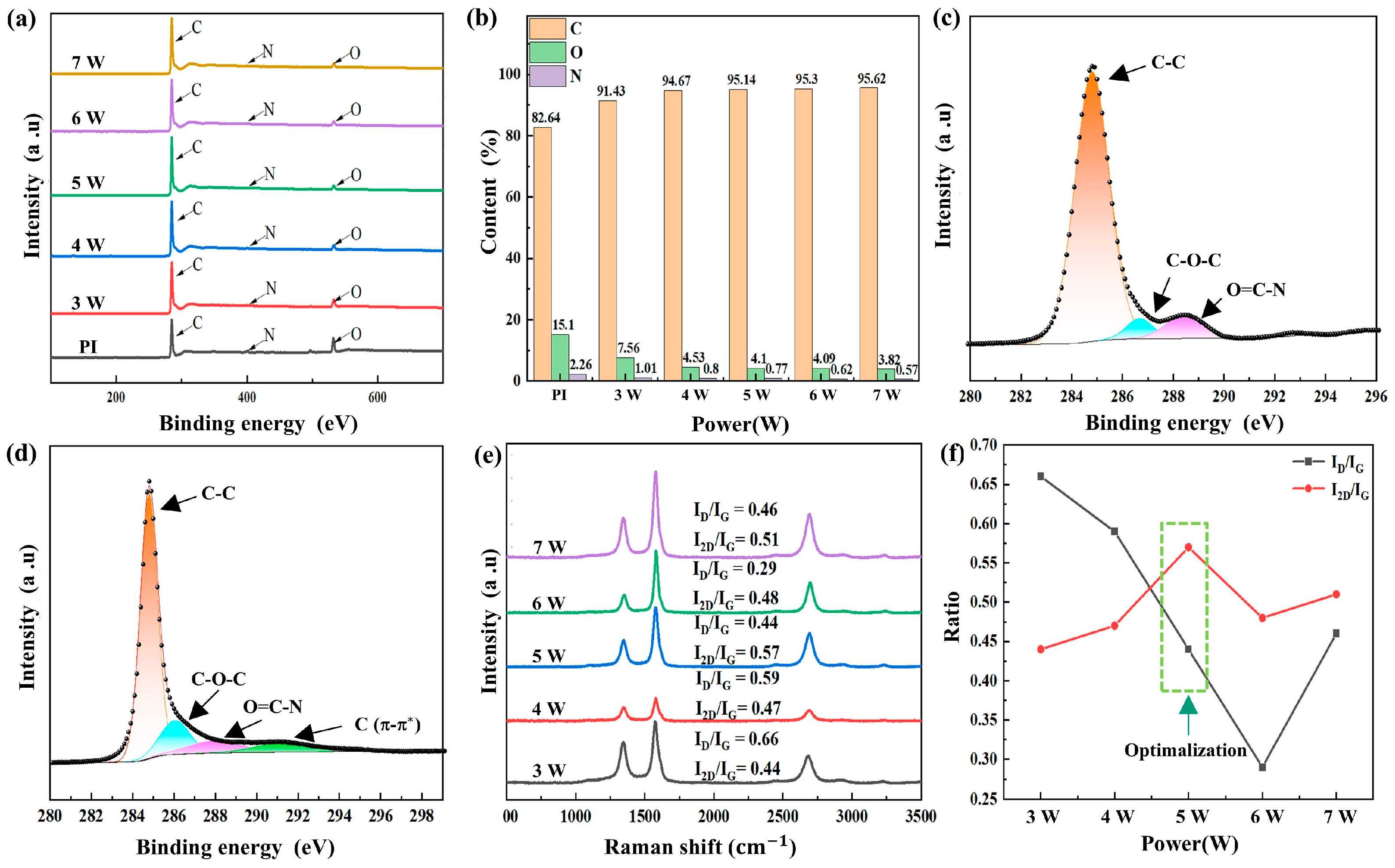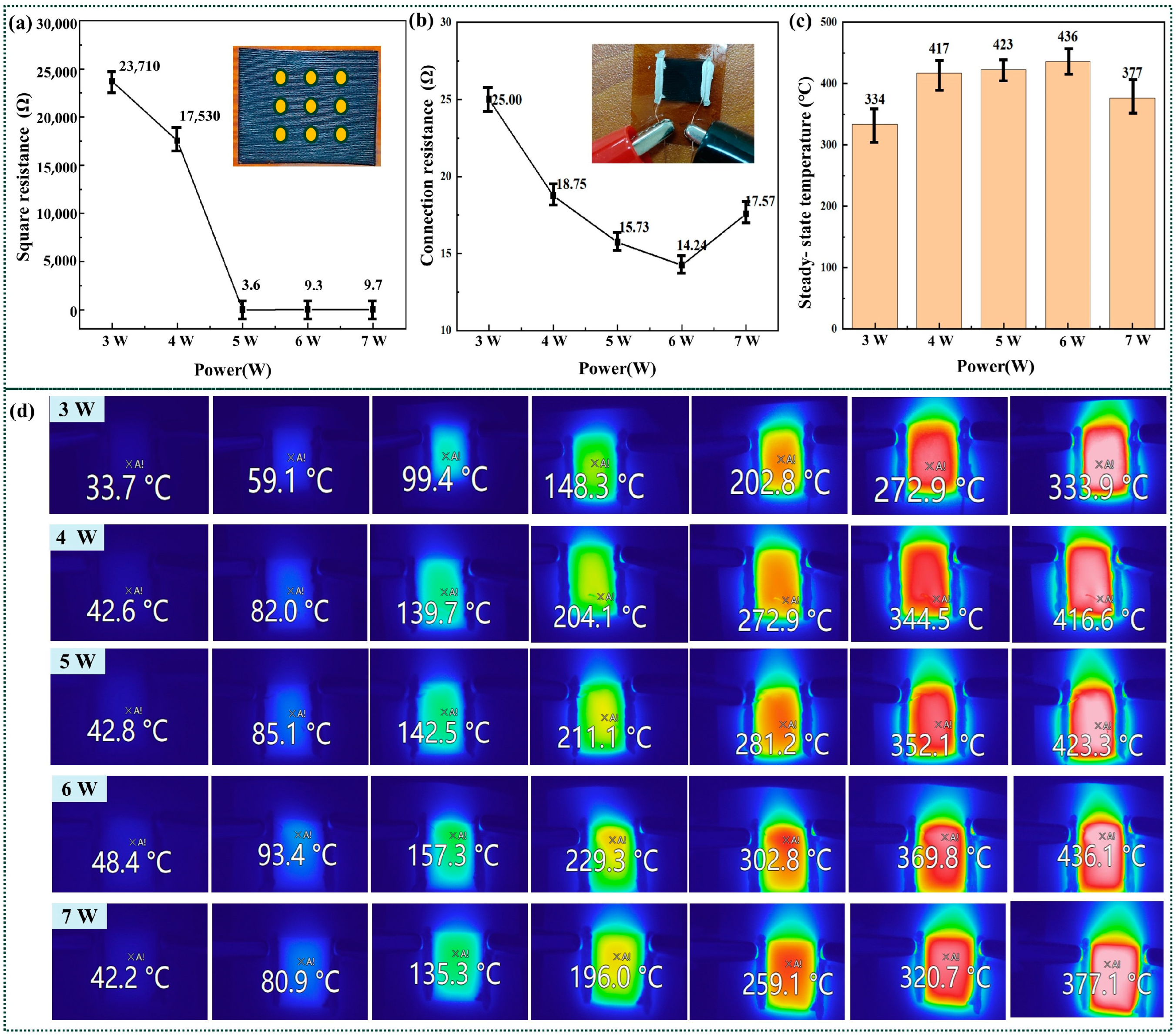One-Step Fabrication of Composite Hydrophobic Electrically Heated Graphene Surface
Abstract
:1. Introduction
- A one-step synthesis method was proposed for the fabrication of composite graphene surfaces with hydrophobicity and electric heating functionality using laser-induced technology. This approach simplifies the traditional multi-step fabrication process and enhances efficiency;
- By precisely controlling laser power parameters, the microstructure design of the graphene surface has been successfully achieved, thereby imparting not only hydrophobicity but also efficient electric heating performance to the surface;
- A systematic investigation was conducted to examine the impact of laser power on the quality and surface microstructure of graphene, revealing that optimal hydrophobicity can be achieved while ensuring high-quality graphene production by controlling the laser power at 5 W.
2. Materials and Methods
2.1. Material and Characterization Equipment
2.2. Experimental Processing
3. Results and Discussion
3.1. Surface Morphology of LIG
3.2. Hydrophobicity of the LIG
3.3. Electrical Conductivity of the LIG
4. Conclusions
Author Contributions
Funding
Institutional Review Board Statement
Informed Consent Statement
Data Availability Statement
Conflicts of Interest
References
- He, Q.; Li, K.; Xu, Z.; Wang, J.; Wang, X.; Li, A. Research progress on construction strategy and technical evaluation of aircraft icing accretion protection system. Chin. J. Aeronaut. 2023, 36, 1–23. [Google Scholar] [CrossRef]
- Zhu, C.; Zhu, C. Aircraft Icing and Its Protectio; Science Press: Beijing, China, 2016. [Google Scholar]
- Liu, Y.; Wu, Y.; Ma, Y.; Wang, P.; Yu, B.; Pei, X.; Liu, S.; Zhou, F. Reversible thermochromic and heat storage coating for adaptive de/anti-icing and thermal regulation. Chem. Eng. J. 2024, 482, 148837. [Google Scholar] [CrossRef]
- Zhang, S.; Gao, F.; Jiang, Z.; He, Q.; Lu, J.; Hou, Y.; Zhan, X.; Zhang, Q. Bioinspired durable interpenetrating network anti-icing coatings enabled by binders and hydrophobic-ion specific synergies. Chem. Eng. J. 2024, 479, 147836. [Google Scholar] [CrossRef]
- Xue, Y.; Wang, Y.; Wang, Y.; Sui, X.; Liang, W.; Wang, F. A superhydrophobic Fe3O4/PEI nanocomposite film with active activation function for anti-icing/deicing applications. Mater. Today Sustain. 2023, 24, 100588. [Google Scholar] [CrossRef]
- Long, C.; Jing, X.; Xi, L.; Zhan, L.; Bing, W.; Qing, S.; Yu, C.; Yi, W.; Xiang, G.; Chun, L. Micro/nano manufacturing aircraft surface with anti-icing and deicing performances: An overview. Nanotechnol. Rev. 2023, 12, 20230105. [Google Scholar] [CrossRef]
- Wu, H.; Shi, F.; Zhang, Z.; Zhong, Z.; Wei, X. Effect of carbon fiber bundles spacing on composites and their electro-thermal and anti/deicing properties. Mater. Sci. Eng. B 2024, 299, 117021. [Google Scholar] [CrossRef]
- Zhang, W.; Wang, D.; Sun, Z.; Song, J.; Deng, X. Robust super hydrophobicity: Mechanisms and strategies. Chem. Soc. Rev. 2021, 50, 4031–4061. [Google Scholar] [CrossRef]
- Liu, S.; Wang, Y.; Tang, X.; Xu, Z.; Peng, C. Fabrication of polydimethylsiloxane superhydrophobic coatings with self-healing properties using the template method. J. Mater. Eng. Perform. 2024, 33, 1349–1357. [Google Scholar] [CrossRef]
- Pan, R.; Zhong, M.L. Fabrication of superwetting surfaces by ultrafast lasers and mechanical durability of superhydrophobic surfaces. Chin. Sci. Bull. 2019, 64, 1268–1289. [Google Scholar] [CrossRef]
- Li, Z.; Zhen, Z.; Chai, M.; Zhao, X.; Zhong, Y.; Zhu, H. Transparent electrothermal film defoggers and antiicing coatings based on wrinkled graphene. Small 2020, 16, 1905945. [Google Scholar] [CrossRef] [PubMed]
- Xiao, Z.; Chen, C.; Liu, S.; Liu, C.; Liu, W.; Cheng, Z.; Yu, X.; Lu, Y.; Zhang, Y. Endowing durable icephobicity by combination of a rough powder coating and a superamphiphobic coating. Chem. Eng. J. 2024, 482, 149001. [Google Scholar] [CrossRef]
- Zhang, R.; Ding, Z.; Wang, K.; Zhang, H.; Li, J. Enhanced anti/de-icing performance on rough surfaces based on the synergistic effect of fluorinated resin and embedded graphene. Small Methods 2024, 1, 2301262. [Google Scholar] [CrossRef] [PubMed]
- Zhang, B.; Yang, G.; Xu, W.; Duan, J.; Hou, B. Hybrid superamphiphobic anti-corrosion coating with integrated functionalities of liquid repellency, self-cleaning, and anti-icing. J. Mater. Sci. Technol. 2024, 184, 256–268. [Google Scholar] [CrossRef]
- Chen, Q.; Shen, X.; Zhang, Z.; Xu, Q. Robust superhydrophobic SiO2/GPE/MWCNTs durable composite coating with photothermal and electrothermal effect for passive anti-icing/active de-icing. Prog. Org. Coat. 2024, 191, 108438. [Google Scholar] [CrossRef]
- Zhao, Z.; Chen, H.; Zhu, Y.; Liu, X.; Wang, Z.; Chen, J. A robust superhydrophobic anti-icing/de-icing composite coating with electrothermal and auxiliary photothermal performances. Comp. Sci. Technol. 2022, 227, 109578. [Google Scholar] [CrossRef]
- Hou, Y.; Wang, M.; Choy, K.L. Scalable high-efficiency multilayered anti-icing/de-icing coating: Superhydrophobic upper layer boosts the performance of the electrothermal system. Prog. Org. Coat. 2022, 168, 106866. [Google Scholar] [CrossRef]
- Fan, J.; Long, Z.; Wu, J.; Gao, P.; Wu, Y.; Si, P.; Zhang, D. Electrothermal superhydrophobic epoxy nanocomposite coating for anti-icing/deicing. J. Coat. Technol. Res. 2023, 20, 1557–1568. [Google Scholar] [CrossRef]
- Duy, L.X.; Peng, Z.; Li, Y.; Zhang, J.; Ji, Y.; Tour, J.M. Laser-induced graphene fibers. Carbon 2018, 126, 472–479. [Google Scholar] [CrossRef]
- Ye, R.; James, D.K.; Tour, J.M. Laser-induced graphene. Acc. Chem. Res. 2018, 51, 1609–1620. [Google Scholar] [CrossRef]
- Kim, K.Y.; Choi, H.; Tran, C.V.; In, J.B. Simultaneous densification and nitrogen doping of laser-induced graphene by duplicated pyrolysis for supercapacitor applications. J. Power Sources 2019, 441, 227199. [Google Scholar] [CrossRef]
- Li, Y.; Luong, D.X.; Zhang, J.; Tarkunde, Y.R.; Kittrell, C.; Sargunaraj, F.; Ji, Y.; Arnusch, C.J.; Tour, J.M. Laser-induced graphene in controlled atmospheres: From superhydrophilic to superhydrophobic surfaces. Adv. Mater. 2017, 29, 1700496. [Google Scholar] [CrossRef] [PubMed]
- Tittle, C.M.; Yilman, D.; Pope, M.A.; Backhouse, C.J. Robust superhydrophobic laser-induced graphene for desalination applications. Adv. Mater. Technol. 2018, 3, 1700207. [Google Scholar] [CrossRef]
- Nasser, J.; Lin, J.; Zhang, L.; Sodano, H.A. Laser induced graphene printing of spatially controlled super-hydrophobic/hydrophilic surfaces. Carbon 2020, 162, 570–578. [Google Scholar] [CrossRef]
- Lee, J.U.; Lee, C.W.; Cho, S.C.; Shin, B.S. Laser-induced graphene heater pad for de-icing. Nanomaterials 2021, 11, 3093. [Google Scholar] [CrossRef] [PubMed]
- Deshmukh, S.; Banerjee, D.; Quintero, J.S.M.; Fishlock, S.J.; McLaughlin, J.; Waghmare, P.R.; Roy, S.S. Polarity dependent electrowetting for directional transport of water through patterned superhydrophobic laser induced graphene fibers. Carbon 2021, 182, 605–614. [Google Scholar] [CrossRef]
- Han, Y.; Han, Y.; Sun, J.; Liu, H.; Luo, X.; Zhang, Y.; Han, L. Controllable nanoparticle aggregation through a superhydrophobic laser-induced graphene dynamic system for surface-enhanced Raman scattering detection. ACS Appl. Mater. Interfaces 2022, 14, 3504–3514. [Google Scholar] [CrossRef] [PubMed]
- Wu, W.; Liang, R.; Lu, L.; Wang, W.; Ran, X.; Yue, D. Preparation of superhydrophobic laser-induced graphene using taro leaf structure as templates. Surf. Coat. Technol. 2020, 393, 125744. [Google Scholar] [CrossRef]
- Wang, W.; Lu, L.; Lu, X.; Liang, Z.; Tang, B.; Xie, Y. Laser-induced jigsaw-like graphene structure inspired by Oxalis corniculata Linn. leaf. Bio-Des. Manuf. 2022, 5, 700–713. [Google Scholar] [CrossRef]
- He, Q.; Ma, Y.; Wang, X.; Jia, Y.; Li, K.; Li, A. Superhydrophobic flexible silicone rubber with stable performance, anti-icing, and multilevel rough structure. ACS Appl. Polym. Mater. 2023, 5, 4729–4737. [Google Scholar] [CrossRef]
- Li, A.; Wei, Z.; Zhang, F.; He, Q. A high reliability super hydrophobic silicone rubber. Colloids Surf. A Physicochem. Eng. Asp. 2023, 671, 131639. [Google Scholar] [CrossRef]
- He, Q.; Xu, Y.; Zhang, F.; Jia, Y.; Du, Z.; Li, G.; Shi, B.; Li, P.; Ning, M.; Li, A. Preparation methods and research progress of super-hydrophobic anti-icing surface. Adv. Colloid Interface Sci. 2023, 323, 103069. [Google Scholar] [CrossRef] [PubMed]
- Li, S.; Zhong, M.; Zou, Y.; Xu, M.; Liu, X.; Xing, X.; Zhang, H.; Jiang, Y.; Qiu, C.; Qin, W.; et al. Fabrication of micron-structured heatable graphene hydrophobic surfaces for deicing and anti-icing by laser direct writing. Coatings 2023, 13, 1559. [Google Scholar] [CrossRef]
- Zhong, M.; Li, S.; Zou, Y.; Fan, H.; Jiang, Y.; Qiu, C.; Luo, J.; Yang, L. Hydrophobic surface array structure based on laser-induced graphene for deicing and anti-icing application. Micromachines 2024, 15, 285. [Google Scholar] [CrossRef] [PubMed]
- Han, Y.; Han, Y.; Huang, Y.; Wang, C.; Liu, H.; Han, L.; Zhang, Y. Laser-induced graphene superhydrophobic surface transition from pinning to rolling for multiple applications. Small Methods 2022, 6, 2200096. [Google Scholar] [CrossRef]
- Wang, Y.; Wang, Y.; Zhang, P.; Liu, F.; Luo, S. Laser-induced freestanding graphene papers: A new route of scalable fabrication with tunable morphologies and properties for multifunctional devices and structures. Small 2018, 14, 1802350. [Google Scholar] [CrossRef]
- Jia, Y.; He, Q.; Liu, Y.; Xu, Y.; Wang, J.; Li, A. Anti-icing system based on multi-level micro-nano and electric heating dual structure. Colloids Surf. A Physicochem. Eng. Asp. 2024, 683, 133105. [Google Scholar] [CrossRef]






Disclaimer/Publisher’s Note: The statements, opinions and data contained in all publications are solely those of the individual author(s) and contributor(s) and not of MDPI and/or the editor(s). MDPI and/or the editor(s) disclaim responsibility for any injury to people or property resulting from any ideas, methods, instructions or products referred to in the content. |
© 2024 by the authors. Licensee MDPI, Basel, Switzerland. This article is an open access article distributed under the terms and conditions of the Creative Commons Attribution (CC BY) license (https://creativecommons.org/licenses/by/4.0/).
Share and Cite
Zhong, M.; Li, S.; Fan, H.; Zhang, H.; Jiang, Y.; Luo, J.; Yang, L. One-Step Fabrication of Composite Hydrophobic Electrically Heated Graphene Surface. Coatings 2024, 14, 1052. https://doi.org/10.3390/coatings14081052
Zhong M, Li S, Fan H, Zhang H, Jiang Y, Luo J, Yang L. One-Step Fabrication of Composite Hydrophobic Electrically Heated Graphene Surface. Coatings. 2024; 14(8):1052. https://doi.org/10.3390/coatings14081052
Chicago/Turabian StyleZhong, Mian, Shichen Li, Hongyun Fan, Huazhong Zhang, Yong Jiang, Jinling Luo, and Liang Yang. 2024. "One-Step Fabrication of Composite Hydrophobic Electrically Heated Graphene Surface" Coatings 14, no. 8: 1052. https://doi.org/10.3390/coatings14081052




